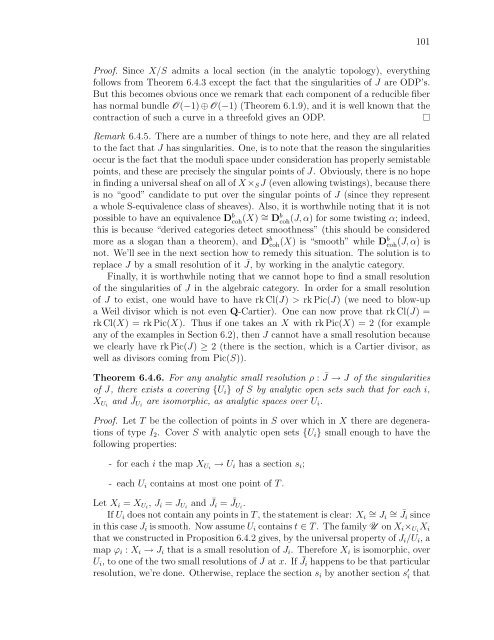derived categories of twisted sheaves on calabi-yau manifolds
derived categories of twisted sheaves on calabi-yau manifolds
derived categories of twisted sheaves on calabi-yau manifolds
You also want an ePaper? Increase the reach of your titles
YUMPU automatically turns print PDFs into web optimized ePapers that Google loves.
101<br />
Pro<str<strong>on</strong>g>of</str<strong>on</strong>g>. Since X/S admits a local secti<strong>on</strong> (in the analytic topology), everything<br />
follows from Theorem 6.4.3 except the fact that the singularities <str<strong>on</strong>g>of</str<strong>on</strong>g> J are ODP’s.<br />
But this becomes obvious <strong>on</strong>ce we remark that each comp<strong>on</strong>ent <str<strong>on</strong>g>of</str<strong>on</strong>g> a reducible fiber<br />
has normal bundle O(−1) ⊕ O(−1) (Theorem 6.1.9), and it is well known that the<br />
c<strong>on</strong>tracti<strong>on</strong> <str<strong>on</strong>g>of</str<strong>on</strong>g> such a curve in a threefold gives an ODP.<br />
Remark 6.4.5. There are a number <str<strong>on</strong>g>of</str<strong>on</strong>g> things to note here, and they are all related<br />
to the fact that J has singularities. One, is to note that the reas<strong>on</strong> the singularities<br />
occur is the fact that the moduli space under c<strong>on</strong>siderati<strong>on</strong> has properly semistable<br />
points, and these are precisely the singular points <str<strong>on</strong>g>of</str<strong>on</strong>g> J. Obviously, there is no hope<br />
in finding a universal sheaf <strong>on</strong> all <str<strong>on</strong>g>of</str<strong>on</strong>g> X ×S J (even allowing twistings), because there<br />
is no “good” candidate to put over the singular points <str<strong>on</strong>g>of</str<strong>on</strong>g> J (since they represent<br />
a whole S-equivalence class <str<strong>on</strong>g>of</str<strong>on</strong>g> <str<strong>on</strong>g>sheaves</str<strong>on</strong>g>). Also, it is worthwhile noting that it is not<br />
possible to have an equivalence Db coh (X) ∼ = Db coh (J, α) for some twisting α; indeed,<br />
this is because “<str<strong>on</strong>g>derived</str<strong>on</strong>g> <str<strong>on</strong>g>categories</str<strong>on</strong>g> detect smoothness” (this should be c<strong>on</strong>sidered<br />
more as a slogan than a theorem), and D b coh (X) is “smooth” while Db coh<br />
(J, α) is<br />
not. We’ll see in the next secti<strong>on</strong> how to remedy this situati<strong>on</strong>. The soluti<strong>on</strong> is to<br />
replace J by a small resoluti<strong>on</strong> <str<strong>on</strong>g>of</str<strong>on</strong>g> it ¯ J, by working in the analytic category.<br />
Finally, it is worthwhile noting that we cannot hope to find a small resoluti<strong>on</strong><br />
<str<strong>on</strong>g>of</str<strong>on</strong>g> the singularities <str<strong>on</strong>g>of</str<strong>on</strong>g> J in the algebraic category. In order for a small resoluti<strong>on</strong><br />
<str<strong>on</strong>g>of</str<strong>on</strong>g> J to exist, <strong>on</strong>e would have to have rk Cl(J) > rk Pic(J) (we need to blow-up<br />
a Weil divisor which is not even Q-Cartier). One can now prove that rk Cl(J) =<br />
rk Cl(X) = rk Pic(X). Thus if <strong>on</strong>e takes an X with rk Pic(X) = 2 (for example<br />
any <str<strong>on</strong>g>of</str<strong>on</strong>g> the examples in Secti<strong>on</strong> 6.2), then J cannot have a small resoluti<strong>on</strong> because<br />
we clearly have rk Pic(J) ≥ 2 (there is the secti<strong>on</strong>, which is a Cartier divisor, as<br />
well as divisors coming from Pic(S)).<br />
Theorem 6.4.6. For any analytic small resoluti<strong>on</strong> ρ : ¯ J → J <str<strong>on</strong>g>of</str<strong>on</strong>g> the singularities<br />
<str<strong>on</strong>g>of</str<strong>on</strong>g> J, there exists a covering {Ui} <str<strong>on</strong>g>of</str<strong>on</strong>g> S by analytic open sets such that for each i,<br />
are isomorphic, as analytic spaces over Ui.<br />
XUi and ¯ JUi<br />
Pro<str<strong>on</strong>g>of</str<strong>on</strong>g>. Let T be the collecti<strong>on</strong> <str<strong>on</strong>g>of</str<strong>on</strong>g> points in S over which in X there are degenerati<strong>on</strong>s<br />
<str<strong>on</strong>g>of</str<strong>on</strong>g> type I2. Cover S with analytic open sets {Ui} small enough to have the<br />
following properties:<br />
- for each i the map XUi → Ui has a secti<strong>on</strong> si;<br />
- each Ui c<strong>on</strong>tains at most <strong>on</strong>e point <str<strong>on</strong>g>of</str<strong>on</strong>g> T .<br />
Let Xi = XUi , Ji = JUi and ¯ Ji = ¯ JUi .<br />
If Ui does not c<strong>on</strong>tain any points in T , the statement is clear: Xi ∼ = Ji ∼ = ¯ Ji since<br />
in this case Ji is smooth. Now assume Ui c<strong>on</strong>tains t ∈ T . The family U <strong>on</strong> Xi×Ui Xi<br />
that we c<strong>on</strong>structed in Propositi<strong>on</strong> 6.4.2 gives, by the universal property <str<strong>on</strong>g>of</str<strong>on</strong>g> Ji/Ui, a<br />
map ϕi : Xi → Ji that is a small resoluti<strong>on</strong> <str<strong>on</strong>g>of</str<strong>on</strong>g> Ji. Therefore Xi is isomorphic, over<br />
Ui, to <strong>on</strong>e <str<strong>on</strong>g>of</str<strong>on</strong>g> the two small resoluti<strong>on</strong>s <str<strong>on</strong>g>of</str<strong>on</strong>g> J at x. If ¯ Ji happens to be that particular<br />
resoluti<strong>on</strong>, we’re d<strong>on</strong>e. Otherwise, replace the secti<strong>on</strong> si by another secti<strong>on</strong> s ′ i that
















